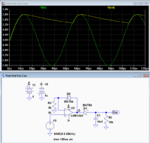Nanaiah
Newbie level 5
I need to design a sallen key filter such that the output of the filter is a pulsating DC or ripple output when compared to the input. I tried implementing the below circuit but the output is not satisfactory. I am getting a sine wave instead of a pulsating dc or a ripple.
Frequency at the input of the filter is 20Khz.
Note: The input of the filter is the result of multiplication of sine and square wave.
Blue wave form - input of filter
Green wave form - output of the filter
and the desired ripple output image is also posted below.
Frequency at the input of the filter is 20Khz.
Note: The input of the filter is the result of multiplication of sine and square wave.
Blue wave form - input of filter
Green wave form - output of the filter
and the desired ripple output image is also posted below.



